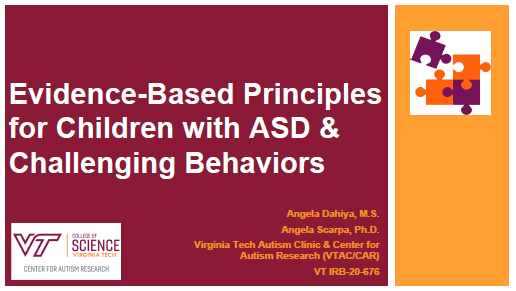Treks Mobile App Parent Support Program for Autism
Treks: Parenting a Child with Autism
The Virginia Tech Autism Clinic & Center for Autism Research aim to improve the quality of life for individuals with Autism Spectrum Disorder (ASD) and their families through intervention, education, and research to inform effective treatment and supports. The “Treks: Parenting a Child with Autism” program is a mobile app based on principles of Applied Behavior Analysis (ABA) and is intended to supplement professional consultation or therapy in order to help parents learn and use skills for managing disruptive behaviors of children with ASD.
Antecedent (A): The antecedent is the situation or event that comes before a behavior.
Behavior (B): The behavior is any detailed action or set of actions that can be observed.
Compliance: When a child is taught to listen and follow through on instructions the first time they hear them. The steps for compliance are the following:
1. Make sure you have your child's attention (either call their name or make sure they are looking at you)
2. Tell (not ask) your child what to do. State the command clearly and only once so your child knows exactly what they are supposed to do.
3. If they do not comply, physically guide them to complete the command (by gesturing, pointing, modeling, or putting your hands over theirs). Ideally you want to use the minimum amount of physical guidance.
4. If they comply, provide praise immediately so they learn that immediate compliance results in immediate reinforcement.
Consequence (C): Consequences describe what happens immediately after, and in response to, a behavior.
Functional Behavior Assessment (FBA): A record of the ABC’s that can help one understand the function of a behavior. Types of functions include: escape/avoidance, attention-seeking, seeking a tangible item, or seeking sensory input.
Generalization: The process of increasing the likelihood that newly acquired positive behaviors will occur in different settings (beyond the situation in which the training of this behavior took place). The strategies to do this include the following:
1. Reinforce across different settings!
2. Use reinforcers that naturally occur depending on the setting.
3. If a situation is substantially different from the setting in which the skill was learned, sometimes the new skill will not generalize.
4. Make sure that behavior problems are not being reinforced in situations outside of the home. Discuss any new behavior or skill changes with your child's teachers and treatment providers so everyone is on the same page!
Maintenance: The process of promoting the continuance of newly acquired positive behaviors. The strategies to do this include the following:
1. Continue to reinforce! This is very necessary in order to maintain a behavior.
2. Fade reinforcement of the new skill to a more realistic and natural reinforcement schedule (e.g. intermittent reinforcement or delayed reinforcement)
Planned Ignoring: A type of consequence that can be used to reduce attention-seeking behaviors. While doing this, one must avoid eye contact with the child, use a neutral facial expression, avoid talking to the child, and walk away from the child.
Prevention Strategies: Techniques that can be used to manage the antecedent of a behavior.
Prompting: A strategy to help a child learn new skills while being given direction at the same time. Types of prompting include: modeling, verbal prompts, visual prompts, physical prompts, stimulus prompts, and time delay.
Reinforcement: Reinforcement can include any item, activity, and/or social response (e.g., food, toys, activities, praise, attention) that will increase the likelihood of a behavior occurring. They can be used to promote desired behaviors or teach children new skills.
Teaching Techniques: Strategies used to teach a child new skills beyond their target behavior. The tips for teaching new skills are the following:
1. Start simple when teaching a new skill. Your child is more likely to comply with learning new skills if the initial tasks are not overly demanding.
2. Teach in a more structured and distraction-free environment.
3. Try to teach these skills in a natural setting or environment.
4. Always reinforce a job well done! This will promote learning new skills in the future. Sometimes reinforcements for each step of a difficult task are necessary.
Visual Schedules: A technique used to help children understand their routines and transitions while coping with any unexpected changes that may come about.




